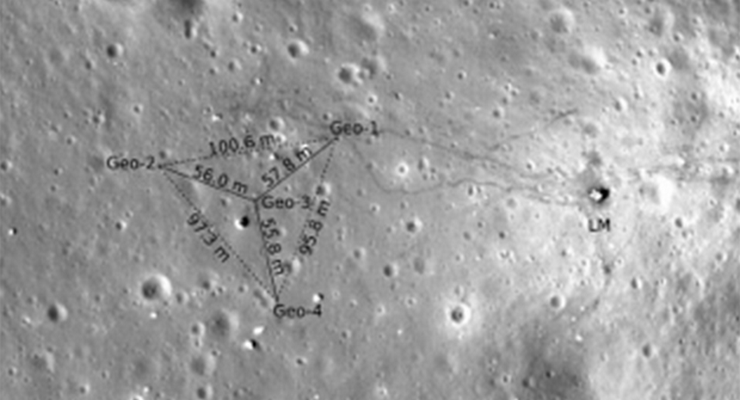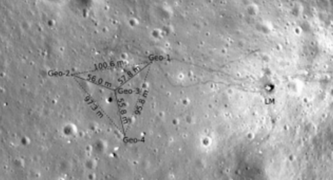
Position of the seismometers on the Moon from Apollo 17. A fiber-optic-based seismic detector, using distributed acoustic sensing, could function as the equivalent of hundreds of seismometers. [Credit: Nunn, C., Garcia, R. F., Nakamura, Y., Marusiak, A. G., Kawamura, T., Sun, D., et al. (2020). Lunar Seismology: A Data and Instrumentation Review. Space Science Reviews, 216(5), 89.]
As National Aeronautics and Space Administration prepares to return to the Moon with its upcoming Artemis missions, researchers at the California Institute of Technology in Pasadena are proposing a new seismological technology that could revolutionize the way lunar quakes are measured. The study, published on April 10 in the journal Earth and Planetary Science Letters, demonstrates that distributed acoustic sensing (DAS) would be able to detect moonquakes with unparalleled accuracy.
Lunar quakes, unlike those on Earth, are not caused by tectonic activity. Instead, they originate from various sources, including day-to-night temperature variations, Earth’s gravitational pull, and the Moon’s gradual cooling and contraction. Understanding the nature and occurrence of these quakes is crucial for planning future lunar missions, especially if permanent structures like a lunar base are to be built on the Moon’s surface.
“Another advantage of using DAS on the Moon is that a fiber optic cable is physically quite resilient to the harsh lunar environment: high radiation, extreme temperatures, and heavy dust,” said Qiushi Zhai, postdoctoral scholar research associate in geophysics at California Institute of Technology and lead author of the study.
DAS technology, developed by Professor of Geophysics Zhongwen Zhan (PhD ’13) over the past decade, involves sending lasers through a fiber optic cable and measuring changes in the laser light as the cable experiences vibrations. This effectively turns the cable into a series of hundreds of individual seismometers, allowing for highly precise quake measurements. A recent study showed that a 100-kilometer stretch of cable could function as the equivalent of 10,000 seismometers.
To test the feasibility of using DAS on the Moon, the researchers deployed a fiber optic cable equipped with the technology in Antarctica, the closest Earth analog to the lunar environment. The DAS sensors successfully measured small vibrations caused by ice cracking and moving, indicating their potential to detect moonquakes.
The next steps for the California Institute of Technology team are to demonstrate that DAS can operate with the limited power resources available on the Moon and to conduct further modeling and analysis to determine the minimum size and distance of detectable quakes.
The study’s co-authors include Research Professor of Geophysics Allen Husker, DAS Scientist Ettore Biondi, former California Institute of Technology postdoctoral scholars Jiuxun Yin and Francesco Civilini, and Luis Costa of National Aeronautics and Space Administration’s Jet Propulsion Laboratory, which is managed by California Institute of Technology. Funding for the research was provided by the National Science Foundation, the United States Geological Survey, the Gordon and Betty Moore Foundation, and the Braun Trust.














 14 comments
14 comments


